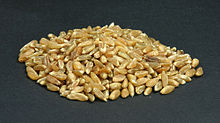Grünkern


Grünkern (German pronunciation: [ˈɡʁyːnkɛʁn], 'green kernel') is spelt that has been harvested when half ripe and then artificially dried. As a reaction to periods of adverse weather, which destroyed crops, spelt was harvested before it was ripe during the so-called 'dough-ripe phase' at about 50% moisture content. Because the dried kernels exhibited a pleasing taste when cooked with water, it became a tradition to harvest a portion of the spelt as Grünkern.
As a winter grain, the spelt meant for Grünkern was yielded at the end of July and subsequently kilned, traditionally over a beechwood fire or in modern heated-air ovens. This preserves the Grünkern (reducing moisture content to 13%) and lends its typical smell and flavor. Before further processing, Grünkern must be husked or milled. Grünkern husk has been used as a filler for small pillows, which are meant to promote healthy sleep. In addition, husk is used as cattle feed.
The first known use was in southern Germany, Amorbach in 1660.[citation needed] Grünkern was added to soups and was dried by using the residual heat of bakehouses.
The primary harvesting period at the end of July is also seen in old folk proverbs, such as:
Christine, Jagowi, Sankt Anne is Ern! / Schneid't mer kee Korn, / so schneid't mer doch Keern.
Christopher, James, Saint Anne it's harvest time! We don't cut grains, but we cut Grünkern.
See also
- Freekeh prepared from green wheat by drying and burning
